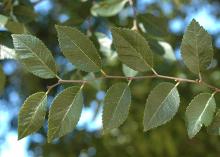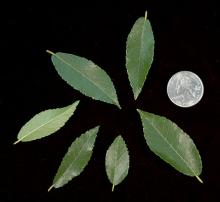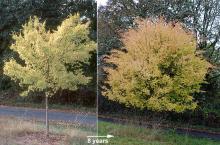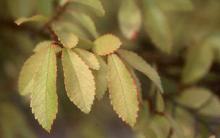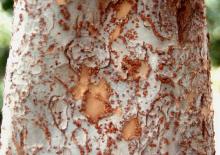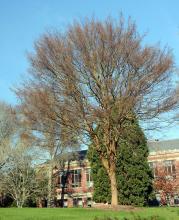Ulmus parvifolia
Common name:
Lacebark Elm
Chinese Elm
Pronunciation:
UL-mus par-vi-FO-li-a
Family:
Ulmaceae
Genus:
Type:
Broadleaf
Native to (or naturalized in) Oregon:
No
- Broadleaf deciduous tree, 40-50 ft (12-15 m) tall, width somewhat less, dense habit, rounded, often with, pendulous branches, other forms upright. Bark is somewhat smooth often with a mottled, flaking combination of gray, green, brown, and orange. Leaves simple, alternate, 2-7 cm long, 0.8-4 cm wide, elliptic to ovate to obovate, unequal rounded at the base, usually simply serrate, glossy dark green and smooth above, pubescent below, (fall color varies from green (evergreen to semi-evergreen), yellow (usual), to red), petiole 0.6-1.3 cm. Flowers in late summer in axillary clusters Fruit (samara) about 1 cm long, elliptic-ovate, with a notch at the apex, seed in the center, may persist into early winter.
- Sun. Adaptable to soil and acidity, best in moist, well-drained, fertile soil. Tolerant to urban conditions. Resistant to Dutch elm disease.
- Be aware that the much inferior Siberian Elm (Ulmus pumila) is sometimes sold as Chinese Elm. The Lacebark Elm name was developed to distinguish Ulmus parvifolia from Ulmus pumila and to emphasize its attractive bark.
- Hardy to USDA Zone 5 Native to northern and central China, Japan, and Korea.
-
Many cultivars and hybrids with considerable variation in form, Dirr (1998) gives descriptions of 28 and Jacobson (1996) lists 24. Here a few:
- ALLÉE® - tree with arching branches and an upright vase habit, it may reach a height of 50 ft (15 m) and a spread of 35 ft (11 m)
- Bosque™ - tree with ascending branches, a dominant central leader, and a pyramidal-columnar form, possibly ~45 ft tall and ~30 ft wide (14 x 9 m)
- ‘Frosty’ - tree/shrub, slow growing, to 8 ft (2.5 m) tall, leaves small, green but edged with white, some completely white.
- ‘Hakkaido’ - very dwarf tree or low growing shrub, leaves very small, leathery
- ‘Seiju’ - dwarf, slow growing, 2-10 ft (0.6-3 m) tall, bark corky with age, leaves tiny, about 0.6-1 cm long, and rounded.
- A popular tree for bonsai.
- parvifolia: parvus, small, folium, leaf.
- Oregon State Univ. campus: on the west side and northeast corner of the Valley Library quad


